Stewardship Reporting Best Practices for Finance Teams: Tips for Showing Donor Impact

Sharing your organization’s impact goes beyond presenting figures—it’s about cultivating trust, highlighting outcomes, and nurturing meaningful connections with donors. For finance teams in donor-focused and grant-funded organizations, working hand-in-hand with fundraising partners is critical to crafting reports that truly engage and tell a story.
By synchronizing data platforms and aligning objectives across teams, you can guarantee transparency in tracking every dollar raised and spent. Stewardship reports don’t just inform donors about financial allocations—they serve as vital proof that their support drives real change.
When your organization harnesses integrated tools, you enable teamwork, precision, and productivity in donor communications. Let’s dive into how stewardship reporting can build confidence both within your organization and among supporters while emphasizing the value of your mission.
Types of Stewardship Reporting
Different funders and donors need different information. Here are a few of the types of stewardship reports organizations often use to communicate impact to stakeholders.
Donor Impact Reports
Donor impact reports are a personalized way to show contributors the tangible results of their generosity. For example, if a donor supports a scholarship program, their report might highlight the students who benefited, including testimonials or achievements. Sending these reports alongside heartfelt thank-you messages provides a double layer of appreciation, reinforcing their connection to your organization.
Grant Reports
Grant stewardship requires detailed reporting on how funds were allocated and whether they achieved the intended outcomes. For finance teams, grant reporting involves aligning financial data with program-specific outcomes. If your community outreach programs are grant-funded, your funder likely requires you to report key metrics like the number of individuals served or how you were able to expand your programs into new areas.
Annual Impact Reports
Annual impact reports give donors a big-picture view of your organization’s accomplishments over the year. Finance and fundraising teams must collaborate closely to ensure data pulled from the CRM aligns with financial records. Your annual report might include a list of your major contributors and their tiers, your active programs, and a basic financial statement to show your revenue and expenses. First-person testimonials from beneficiaries help connect donations to a face and personal story.
Project-Specific Stewardship Report
When donors give toward specific initiatives, project-based stewardship reports help demonstrate accountability. For example, donors who supported a capital campaign might receive a report outlining progress toward construction milestones, complete with photos and budget updates.
Endowment Reports
Endowment stewardship provides your donors and stakeholders transparency about long-term funds. These reports should detail fund growth, investment performance, and disbursement of income to support your mission. For instance, an endowment report might showcase how interest income funded critical research or provided scholarships.
By tailoring stewardship reporting to each type of donor contribution, you can help donors feel valued and confident that their gifts are making a meaningful impact.
Compliance Requirements: What Is Essential to Include?
Effective stewardship reporting not only builds trust with donors but also ensures compliance with legal and ethical obligations. By adhering to clear guidelines and tailoring reports to donor preferences, organizations can strengthen transparency and foster lasting relationships.
Restricted Gift Compliance
Your reports should document how donor-restricted funds were used in line with their intended purposes. For example, if a donation was earmarked for purchasing medical equipment, the report must verify that funds were used accordingly. If funds were used for other purposes without donor consent, the donor could pursue legal action, or in the case of grant funding, require the funds to be returned.
Program Outcome Measurements
Stewardship reporting should demonstrate the outcomes of programs funded by donors. For instance, if a gift supported an after-school literacy program, your report could highlight statistics like the number of children served and improvements in reading levels.
Stewardship of Endowed Funds
Endowed funds require regular reporting on investment growth, income allocation, and how the income supports specific initiatives. Regulations like Uniform Prudent Management of Institutional Funds Act (UPMIFA) provide guidelines for managing and investing endowment funds responsibly. For example, a university might issue reports to donors explaining how their endowed scholarship fund supported multiple students during the academic year.
Partnerships and Pass-Through Grants
If your organization manages pass-through grants or collaborates with partner organizations, stewardship reports must document these arrangements transparently. This includes detailing the allocation of funds and the outcomes achieved through partnerships.
By involving both finance and fundraising teams in these compliance processes, you can ensure that the right data is collected, verified, and shared in a way that fosters donor trust and meets regulatory requirements.
Ways the Finance Team Can Level Up Reporting for Donors
With sub-fund accounting to provide granular and accurate data, the finance team can provide the fundraising team with the information they need to communicate effectively with donors.

Milestone-Based Reporting
For large-scale projects like capital campaigns, milestone-based reporting provides donors with regular updates on progress. For instance, you might report on the completion of specific construction phases, accompanied by financial updates to reassure donors that funds are being used effectively.
Multi-Year Impact Trajectories
Donors supporting multi-year initiatives benefit from seeing the trajectory of their contributions over time. For example, a report could outline the historical growth of a scholarship program, showcasing the increasing number of beneficiaries.
Benchmark Comparisons
Including benchmark comparisons in your reports can provide donors with valuable context. For example, showing how your program’s outcomes compare to industry averages—such as higher-than-average graduation rates—helps validate your organization’s effectiveness.
Funding Impact Highlights
Highlighting key achievements tied to donor contributions can inspire further giving. For instance, if donor funds supported an environmental initiative, reports could emphasize measurable successes like the number of trees planted or habitats restored.
Ecosystem Impact Analysis
To paint a broader picture, incorporate ecosystem impact analysis in your stewardship reporting. For example, you might showcase how a donor-funded program indirectly benefited an underserved community by improving access to education, healthcare, or economic opportunities.
By leveraging these strategies, finance teams can elevate stewardship reporting and strengthen donor trust through transparency and meaningful insights.
Stewardship-Focused KPIs to Measure Success
Here are a few metrics to include in your stewardship reports to highlight the impact you are making and build trust with donors and funders.
ROI of Programs and Initiatives
Tracking the return on investment for donor-funded programs demonstrates efficiency. For example, a literacy program might calculate the cost per student served versus the overall impact on reading proficiency.
Cost Per Outcome
Cost per outcome ties your expenses to a specific goal, making it easier to identify funding needs. For instance, you might report the cost per meal provided through a donor-funded food assistance program.
Milestone Achievement Rate
For large-scale initiatives, milestone achievement rates showcase progress. For example, reporting that 75% of planned construction phases are complete shows donors that their contributions are driving tangible results.
Year-Over-Year Growth
Demonstrating growth can inspire further support. Reporting a 15% increase in beneficiaries served from one year to the next, for instance, shows donors that your organization is expanding its impact, or that the need for your services is growing.
By focusing on these KPIs, you can measure success, improve accountability, and deliver actionable insights that resonate with donors.
Whitepaper
4 Ways Personalized Reporting Helps Your Nonprofit Make Better Strategic Decisions
Distributing Your Stewardship Reports
Efficiently distributing stewardship reports requires thoughtful strategies, so stakeholders receive timely, accurate information. Automating report generation is a game-changer for organizations managing large donor bases. Automated systems can email personalized donor reports shortly after each contribution, for example, saving time while maintaining consistent communication.
Self-service dashboards further enhance the process by enabling development teams to access real-time financial data without waiting for manual updates. For instance, a dashboard showing ROI metrics for each program helps fundraisers answer donor questions on the spot.
Understanding critical timeframes, such as month-end financial close, is equally important. The fundraising team needs to know that, if they log into their dashboard to answer a question from the donor, information might not be updated with month-end numbers until the 10th of the following month, for example.
Making Stewardship Reporting More Efficient with a Connected Ecosystem
A connected fundraising and fund accounting system revolutionizes stewardship reporting by breaking down silos and enabling real-time collaboration. When donor contributions are recorded in your CRM, finance teams can easily verify compliance with donor restrictions through integrated fund accounting tools.
Integrated fund accounting and fundraising systems also improve accuracy. By eliminating the need for manual data transfers between systems, you reduce the risk of errors and ensure that reports align with donor intent. For instance, when a development officer tracks major donor pledges in the CRM, finance can access these updates to forecast revenue.
Real-time data sharing empowers both teams to respond quickly to donor inquiries. Imagine a donor calls with questions about their contributions—your connected system allows fundraisers to pull up detailed reports in seconds, strengthening trust and transparency.
Ultimately, these systems help you demonstrate accountability, save time, and create a seamless experience for donors.
Better Stewardship Reporting with Blackbaud’s Connected Ecosystem
Unite your fundraising and finance teams to achieve your most ambitious goals. With a seamless integration between Blackbaud Raiser’s Edge NXT® and Blackbaud Financial Edge NXT®, you can identify funding opportunities and market trends to drive deeper stewardship with potential funders and donors.
Learn more about the benefits of an integrated fundraising and fund accounting system built specifically for not-for-profit organizations.


